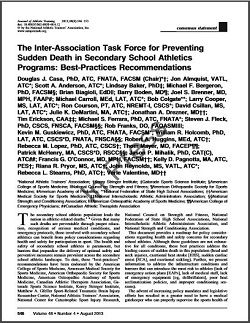The Inter-Association Task Force for Preventing Sudden Death in Secondary School Athletics Programs: Best-Practices Recommendations
by NSCA
Other
May 2014
This consensus statement provides specific conditioning recommendations with the intent of ending conditioning-related morbidity and deaths of secondary school athletes. Most deaths in sports are preventable; our charge is to meet this expectation.
Paywall block issue
This article is not configured properly for members or paid content.
isMemberOnly: {{isMemberOnly}} | isPaidContent: {{isPaidContent}}
spc: One or more parts of the product SPC is missing.
Read the full article
View the video
Login to view more
This {{ogType == 'video.other' ? 'video':'article'}} is available with a NSCA membership
or can be purchased for {{prices}}
or can be purchased. Price range: {{prices}}
Price includes membership pricing and promotions
This {{ogType == 'video.other' ? 'video':'article'}} can be purchased for {{prices}}
Price includes membership pricing and promotions
Purchase this {{ogType == 'video.other' ? 'video':'article'}}. Price range: {{prices}}
Price range includes membership pricing and promotions
Essential Reading

The secondary school athletic population leads the nation in athletic-related deaths. Given that many such deaths are preventable through proper education, recognition of serious medical conditions, and emergency protocols, those involved with secondary school athletics can benefit from policy considerations regarding health and safety for participation in sport. The health and safety of secondary school athletes is paramount, but barriers that jeopardize the delivery of optimal safety and preventive measures remain prevalent across the secondary school athletic landscape.
To date, these ‘‘best-practices’’ recommendations have been endorsed by the American College of Sports Medicine, American Medical Society for Sports Medicine, American Orthopaedic Society for Sports Medicine, American Osteopathic Academy of Sports Medicine, Canadian Athletic Therapists Association, Gatorade Sports Science Institute, Korey Stringer Institute, Matthew A. Gfeller Sport-Related Traumatic Brain Injury Researcher Center, National Athletic Trainers’ Association, National Center for Catastrophic Sport Injury Research, National Council on Strength and Fitness, National Federation of State High School Associations, National Interscholastic Athletic Administrators Association, and National Strength and Conditioning Association.
This document provides a roadmap for policy considerations regarding health and safety concerns for secondary school athletes. Although these guidelines are not exhaustive for all conditions, these best practices address the leading causes of sudden death in this population (head and neck injuries, exertional heat stroke [EHS], sudden cardiac arrest [SCA], and exertional sickling). Further, we present information to address the infrastructure conditions and barriers that can introduce the most risk to athletes (lack of emergency action plans [EAPs], lack of medical staff, lack of emergency equipment [eg, defibrillators], poor heat acclimatization policies, and improper conditioning sessions).
The advent of increasing policy mandates and legislative efforts has resulted in a greater need to have a medical gatekeeper who can properly supervise the sports health of the secondary school athletes. This includes the policies, mandates, and laws that have been created to enhance the health and safety of these athletes. In addition, most of the deaths in secondary school sports can be avoided by providing appropriate prevention, recognition, and treatment strategies. Accordingly, supervisors of secondary school athletics programs would benefit greatly from having an athletic trainer (AT) who can guide these efforts. As James Roscoe Day said when chancellor of Syracuse University and after President Theodore Roosevelt mandated changes in collegiate football to decrease the number of deaths: ‘‘One human life is too big a price for all the games of the season.’’ Day helped to overhaul the rules of collegiate football and form the National Collegiate Athletic Association because President Roosevelt provided this mandate, showing that smart implementation of policy changes and oversight can dramatically enhance the safety of sport participation. Therefore, the purpose of this consensus statement is to provide a similar benefit through recommendations and guidelines for best practices. Most deaths in sports are preventable; our charge is to meet this expectation.
References
Douglas Casa, et al.
Journal of Athletic Training
Volume 48, Number 4, 2013
